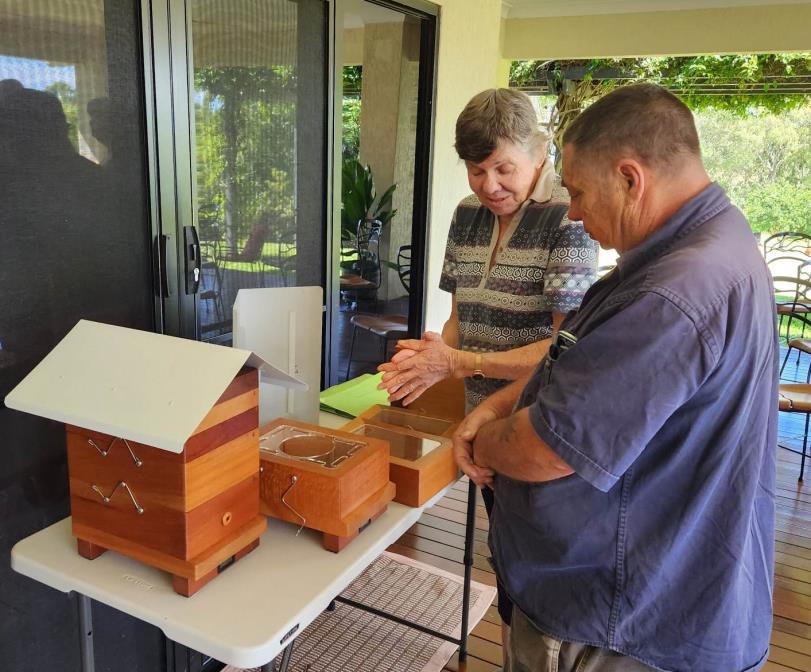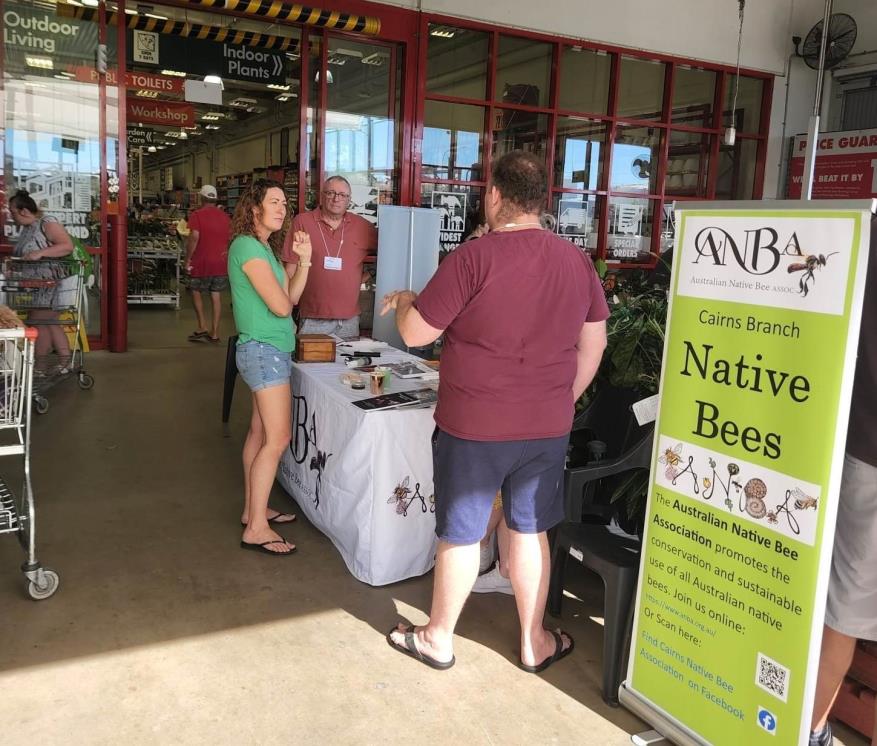Cairns branch news
Propagation with Wendy Forno respected Entomologist and Native Bee Enthusiast
Propagation is something we read about daily on our Facebook forums. People have varying passionate views about the different methods. This article is not to say that Splitting or Brood lifts are better than the Eduction or Buddy method, rather it gives insight to that form of propagation. It concentrates on recognising the importance of brood architecture.

Wendy is the first person to admit that there are many opinions and methods when working with native bees. She has been studying and propagating native bees for many years where she lives on the Tablelands outside the FNQ town of Atherton. She spoke at our last Branch meeting and asked us to consider why we keep bees. She believes that we as bee keepers have to look at the theory out there and devise practical methods to balance the theory with what is feasible. Do we keep bees for the aesthetic and personal health benefits of watching hives every day, to split / brood lift and propagate, to study them in a scientific way or perhaps for honey production?
If we are wanting to propagate our bees Wendy said the best place to start, regardless of the species, was to carefully observe the architecture of the brood and let this guide our decisions. However, she insists that her advice should be seen as a tool, not a rule!
The tablelands of the Cairns region has 4 species of Tetragonula. Carbonarias with their magnificent spiral discs of brood lend themselves very well to a horizontal split. A vertical split could work, but would definitely take longer to recover. After all, success of both hives is the main goal regardless of split or brood lift. The Carbonaria brood discs have small pillar type structures which make great cutting points without damaging or tearing the brood. It is important to be aware of the advancing front and sometimes when you are in the process of a split, consider if the brood is well positioned. If not, and if you continue, you risk losing the second hive. Strength in numbers from healthy brood is very important.
Hockingsii bees are very similar to Carbonaria. Their brood is a series of ‘steps and stairs’ going up and down to make a ball which means you cannot have as clear a cut when splitting, but the volume of the brood gives a fairly good chance to be successful in propagation. Often both Carbonaria and Hockingsii have brood covered with involucrum, but this is not the case with Sapiens.
Sapiens brood is usually much smaller than TC and TH hives. A real question to ask is whether there is enough Sapiens brood to be able to split and have them survive. That’s a question to be considered on a case by case basis.
Now we come to Clypearis who are not like the above-mentioned species with reliable architecture to help with identification. Clypearis brood appears to us to be haphazard and placed randomly. Rather than a brood mass, Clypearis hives may have brood in one corner, some in another and more hanging from the ceiling. This does not lend itself to cutting, but more often selecting portions of brood for a new box. If you have Clypearis hives in the same size box, swapping lids is an option for a brood lift! When taking portions of brood, take some of the old and the new. Old brood is lighter in colour to the new brood. Although we know to try to replicate the orientation of the brood of the original hive into the new, replicating hanging brood is impossible. Contrary to some opinions though, the bees are unlikely to drown if the brood is place upside down.
Now let’s talk about queen cells. When splitting a hive or doing a brood lift we know it’s best to have the queen in one half and queen cells or a virgin queen in the other. Of course, sometimes we don’t know if we have achieved that goal. We now know that with Carbonaria and Hockingsii, when considering the half without the queen, the workers will select a cell with larvae, and build a cell next to this larvae and fill it with food. There is no egg in that cell due to the absence of a queen. However, the larvae next to it, having finished all the food in its cell, will bore through the wall of the cell filled with food and then will emerge as a queen!
A queen does not receive any special food in its cell, just quantity. So, as long as you have enough good quality brood in your second box, the bees will most likely build an emergency queen cell. Research on similar species overseas suggests that this building of emergency queen cells might also be the case for Clypearis. Sapiens are from a different group and so we don’t have any re-search on them.
To finish, Wendy reminded us that brood was incredibly delicate and if damaged during a split or brood lift, can-not be saved. Even though we like to have these jobs done quickly, care and being methodical is more important.
Opportunist hive relocations!
Our members from the tablelands brought up the matter of a wild hive that is under constant attack from people! A hive located in a water meter outside a popular bakery on the tablelands has had the water meter cleared out 9 times in the past 12 months. If we consider what we learnt from Wendy’s talk, it is unlikely that any of those hives will have survived due to the small amount of brood that would have been present. These bees may well have been the advance team trying to set up a new hive by adding stores and structure to a space. We considered many ways of educating people to help them understand that this is not a sustainable practice. The editor of a local publication will be approached to publish an article on the subject.
World Bee Day.
Cairns branch was represented at Bunnings in Central Cairns on Saturday morning.
Our stall was located near the exit which meant maximum foot traffic. We chatted to lots of people, passed out leaflets and encouraged them to join our Facbook group and the ANBA. Bunnings was very accommodating and invited us back whenever we like. Some kind folk even made donations to our branch! The live Sapiens hive and the honey tasting were big hits. There is definitely lots of interest in Cairns for all things related to native bees.
From: Stewart Clarke sclarkehk@gmail.com, Chair and Representative to ANBA
Cairns Native Bee Association Facebook group,
https://www.facebook.com/groups/1269746467098269/

